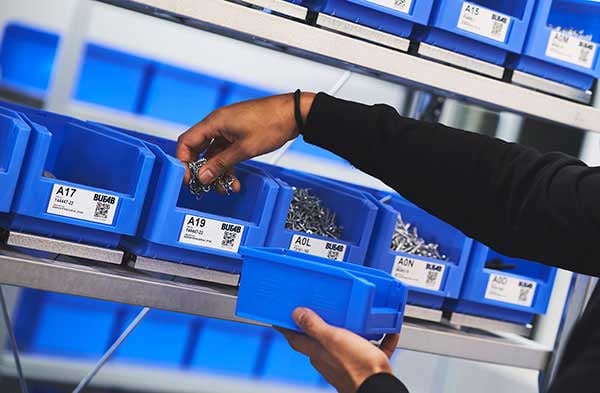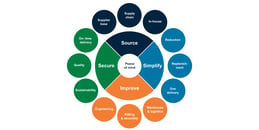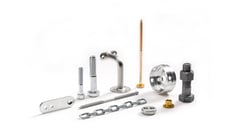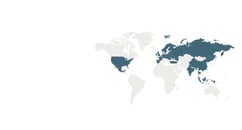- Insights
- The Solutionists Hub
- Supply Chain Strategy Definitions You Should Know
Supply Chain Strategy Definitions You Should Know

Defining your C-parts supply chain strategy is a detailed and complex topic. Becoming a true supply chain expert takes years of study and experience – but unfortunately, this isn’t possible for all of us. I believe that there are a few vital terms and definitions you should know about to have a solid foundation in your supply chain strategy work.
For that reason, I’ll use this article to define and explain a few of these core factors – hopefully, it’ll help provide some clarity within your organization and give you some key pillars to prioritize in future discussions with a supply chain partner or supplier.
As Jacob Bergström has explained in another article, the definition of a supply chain strategy is:
“A supply chain strategy describes the plan of action for your supply chain to achieve the overall business objectives.”
With that in mind, let’s take a look at six key building blocks that I think should go into this strategy.
Quality
Regarding C-parts, the definition of ‘quality’ differs from what you might guess. Here, we’re not talking about the parts’ quality – although it’s essential, especially if your products need to operate well in tough conditions. Instead, it’s the quality of the service you receive from your supplier – are they fast and flexible when your needs change? Do you feel you can rely on them to keep your availability high? Are they genuinely interested in learning more about your company’s unique needs and challenges? Is the supplier responsive? Do they keep you well informed throughout the process? If so, you’re probably dealing with a high-quality supplier.
Cost
The definition that is important to focus on here is not the cost of the parts themselves – the price of C-parts is usually low, so the ‘sticker price of the components doesn’t significantly affect your organization. Instead, you should focus on the total cost of ownership, or TCO. This is the combined cost of all the activities involved in your C-parts purchase – from the cost of sourcing and negotiating to taking delivery and handling the parts in the parts store. These indirect costs are much ‘softer’ than the actual purchase price of the C-parts and make up around 80% of the TCO – so it’s worth looking for a supplier that can provide a lower TCO, either through consolidation or through digital tools that make replenishment and ordering easier. Lower TCO can also be achieved by utilizing the deep knowledge of an experienced supply chain partner in cost-efficiently finding the best source for the product specification and volume you require. Bear in mind that the optimal source might change over time with changes in volume and specification.
Delivery
This is one of the last steps in the supply chain, and it’s of great importance for your production. Deliveries need to arrive on time, to your required specification. If this isn’t the case, you can face disruptions in your production line and maybe even downtime in the worst cases. The supplier’s ability to get the C-parts to you when you need them is a pillar of any supply chain strategy, and it should be at the top of your mind when selecting a supplier that can make your strategy a reality. Given the current global supply chain disruptions, I believe adopting a ‘Just in Case’ strategy is smart. When it comes to C-parts, aim for an efficient (and preferably consolidated) supplier base that can provide effective ‘Just in Case’ buffers and replenishment methods to support a ‘Just in Time’ strategy in the production facility.
Security
Here, we’re talking about the security you need to feel as a manufacturer that your needed parts will be available when you need them. Every company is battling with supply chain disruptions and rising prices in today’s market. However, regardless of the global situation, C-parts availability is non-negotiable. It’s therefore vital that your suppliers or supply chain partner can offer you this security. The last couple of years have shown that the big players, who have a large and flexible global supplier base, numerous distribution centers, and even their own manufacturing operations can provide this kind of security best, so keep this in mind when assessing your strategy.
Trends
It’s essential to be aware of your company’s needs today, but it’s just as necessary to be prepared for your needs in the future, in five, 10, or 20 years. When developing a supply chain strategy, you need to keep these future changes and expansions in mind to ensure it will work over the long term. And it would be best if you found a prepared and proactive supplier in this area. They shouldn’t be standing still but actively monitoring trends, and following or even setting them by themselves. One good example is sustainability, which is already a significant trend for manufacturers – in the future, it won’t just be a trend but a fact of life. Regulations and pressure from shareholders will push your company towards more sustainable production processes – so your strategy needs to allow for this. Other ongoing trends, such as digital transformation, de-globalization (also called localization), and remote work, should also be on your and your supplier’s radar.
Agility
This is an important quality you should always aim for in your own strategy and for your suppliers and partners. Even the most reliable supply chain can sometimes face disruptions – and as we know, disruptions are becoming increasingly common. When this occurs, it’s important to find out what happened – but first, you need to be able to quickly adapt and keep your needed C-parts flowing into your production. To make this possible in your strategy, it’s smart to bring in a supply chain partner who can quickly source your parts elsewhere if the usual distribution channel gets shut off. International trade today is more unpredictable than in the past – so the ability to be agile in times of crisis is crucial.
Hopefully, this article will give you a steady foundation in your thinking around supply chain strategies and your choice of suppliers. If you want to learn more, make sure to take a look at our in-depth guide to C-parts supply chain management, and download our presentation, ‘The Guide to a Seamless Supply Chain of C-Parts’ below.
Download the free guide

The Guide to a Seamless Supply Chain of C-Parts
Get new knowledge every week!
Related
-
By Niklas LindsköldHow do EU sanctions against Russia affect your C-parts operation?
-
By Slawomir BieszkSupply Chain Management Risks, and How to Handle Them
-
By Nick MilesDefining the Objectives of C-Parts Supply Chain Management
-
By Rob KoningsHow Does the C-Parts Supply Chain Management Process Work in Practice?
-
By Jacob BergströmSupply Chain Challenges and How to Overcome Them
-
By Sergio BrambilaSustainable Supply Chain: How to Reduce Your Carbon Footprint
-
By Jacob BergströmSupplier vs. Supply Chain Partner: What to Choose?








